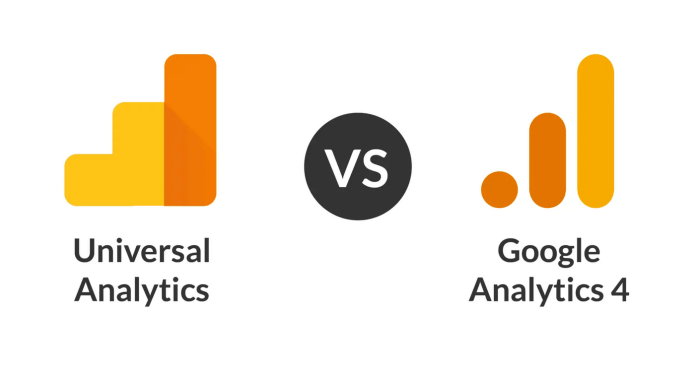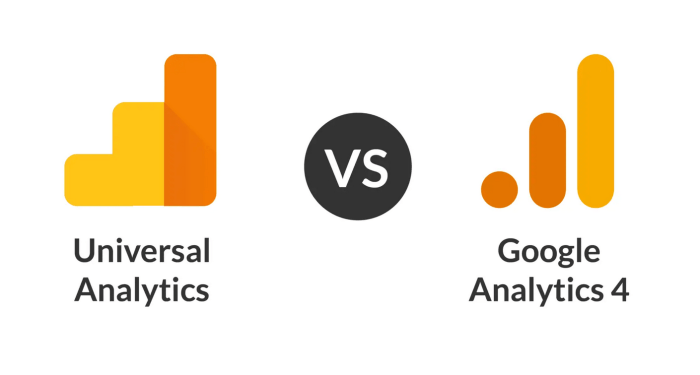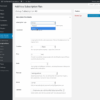Key differences you must be aware of when comparing UA and GA4 metrics are crucial for anyone transitioning to the new Google Analytics 4 (GA4) platform. Understanding the nuances in how data is collected, structured, and reported is vital for accurate analysis and effective decision-making. This deep dive explores the core distinctions between Universal Analytics (UA) and GA4 metrics, shedding light on data structures, reporting impacts, and migration strategies.
This post will dissect the differences in data collection methods, highlighting the fundamental shifts in data structures between UA and GA4. We’ll also explore how these changes impact reporting flexibility and the need for adjustments in your analytical approach. Furthermore, we’ll cover crucial migration considerations and practical steps to avoid potential pitfalls. Finally, we’ll delve into data interpretation and insights, providing examples of leveraging GA4 data for improved decision-making.
Defining UA and GA4 Metrics
Universal Analytics (UA) and Google Analytics 4 (GA4) are both powerful tools for analyzing website traffic and user behavior, but they differ significantly in their data collection methods and metrics. Understanding these differences is crucial for accurately interpreting data and making informed decisions about website optimization.GA4 represents a paradigm shift in how website data is collected and interpreted, moving away from the session-based approach of UA towards a more holistic, user-centric view.
This shift is driven by the need to capture data from a wider range of touchpoints and devices, including mobile apps and other platforms.
Universal Analytics (UA) Metrics
Universal Analytics relies on a session-based model, focusing on user interactions within a single browsing session. Key metrics in UA often track the overall user journey within a defined timeframe.
- Sessions: A session represents a group of interactions with your website within a defined time period (e.g., 30 minutes of inactivity). Sessions are crucial for understanding how many times users visit your site and how long they spend on your site.
- Bounce Rate: The percentage of visitors who leave your website after viewing only one page. A high bounce rate might indicate issues with the user experience or site relevance.
- Pageviews: The total number of pages viewed by users. This provides a basic understanding of site engagement, but doesn’t account for depth of engagement.
- Average Session Duration: The average time users spend on your website during a session. This metric provides insights into how engaging your content is.
- Conversion Rate: The percentage of visitors who complete a desired action (e.g., making a purchase, filling out a form). Conversion rates are vital for understanding how effectively your site drives desired outcomes.
Google Analytics 4 (GA4) Metrics
GA4 moves beyond the session-based model, focusing on user behavior and engagement across various platforms and touchpoints. This data allows for a more comprehensive view of user journeys.
- User Engagement: This is a broad metric that encompasses various user interactions, such as page views, scrolls, clicks, and other actions that demonstrate active participation. GA4 measures this activity more granularly than UA.
- User Behavior: GA4 tracks user behavior across the entire customer journey, including engagement with various platforms, touchpoints, and devices. This allows a deeper understanding of how users interact with your website or app.
- Events: GA4 tracks events as any measurable action a user performs, including button clicks, form submissions, video plays, and more. This detailed tracking is fundamental to GA4’s ability to capture a wider range of user activities.
- Engagement Rate: This reflects the overall activity a user demonstrates on a website or app. This metric is broader than simply bounce rate and focuses more on the user’s active participation and time spent.
- Conversions: Similar to UA, GA4 also tracks conversions, but the definition is broader and can include actions like adding an item to a cart or making a purchase across various touchpoints.
Comparison of UA and GA4 Metrics
| Metric | Universal Analytics (UA) | Google Analytics 4 (GA4) | Key Difference |
|---|---|---|---|
| Sessions | Primary unit of measurement | Less emphasized, user-centric approach | Focus shifts from session-based to user-centric |
| Bounce Rate | Percentage of users leaving after one page view | Engagement rate, encompassing various interactions | A broader understanding of user activity |
| Pageviews | Total pages viewed | One of many events | Detailed event tracking replaces a simple count |
| Average Session Duration | Average time spent per session | Engagement duration across multiple touchpoints | Tracks engagement over a broader scope |
| Conversion Rate | Percentage of users completing desired actions | Conversions tracked across various touchpoints | More comprehensive conversion tracking |
Data Collection Methods
| Feature | Universal Analytics (UA) | Google Analytics 4 (GA4) |
|---|---|---|
| Data Model | Session-based | User-centric, event-based |
| Data Collection | Cookie-based, primarily focused on website traffic | Utilizes a wider range of data collection methods, including cookies, client-side tracking, and data from other platforms |
| Integration | Limited integration with other Google services | Enhanced integration with other Google services and platforms |
| Data Storage | Historical data | Focuses on real-time and incremental data |
| Data Accuracy | Data accuracy depends on cookie acceptance | More accurate data collection, even with reduced cookie use |
Key Differences in Data Structures

Understanding the fundamental differences in how Universal Analytics (UA) and Google Analytics 4 (GA4) structure data is crucial for effective analysis and reporting. While both platforms track user behavior, their underlying data models differ significantly, impacting how you interpret and leverage the insights they provide. This difference in data structures requires a shift in analytical approach, necessitating a deep dive into the new schema.
Data Model Schema Differences
UA employs a hierarchical, multi-dimensional structure, with data organized around sessions and hits. GA4, on the other hand, adopts a more event-driven model. This difference fundamentally alters how data is collected, processed, and analyzed. UA’s structure is more focused on the session as the primary unit of measurement, whereas GA4 centers around individual events.
Understanding the key differences between Universal Analytics (UA) and Google Analytics 4 (GA4) metrics is crucial for accurate analysis. For example, the way GA4 tracks user behavior is significantly different, as detailed in Google’s recent study on user behavior, google ai overviews user behavior study. This means you need to adjust your interpretations to account for these fundamental shifts when comparing data from the two platforms.
Careful consideration of these differences is vital for a correct understanding of your website traffic.
Dimensions in UA and GA4 Reporting
UA utilizes dimensions like session duration, bounce rate, and pages/sessions. GA4, conversely, tracks events such as purchases, add to carts, and page views. These differences in dimensions reflect the contrasting approaches to data collection and analysis.
User Behavior Tracking
UA tracks user behavior within a defined session. GA4 captures user behavior as a series of events, regardless of session boundaries. This shift allows for a more granular understanding of user interactions, as it doesn’t rely on a session’s start and end points to determine user actions. The flexibility of GA4 enables analysis of individual user actions over time.
Event Tracking Capabilities
GA4’s event-based structure significantly expands event tracking capabilities. While UA allows for custom events, GA4’s flexibility allows for far more detailed tracking. Custom parameters can be added to events, enabling a richer understanding of user interactions. This is a significant advancement, as it provides marketers with more data points to analyze. In UA, tracking complex user journeys is less straightforward, while GA4 allows for a more comprehensive view of user interactions.
Comparison Table
| Dimension | Universal Analytics (UA) | Google Analytics 4 (GA4) |
|---|---|---|
| Data Structure | Hierarchical, session-based | Event-driven, no session boundaries |
| Primary Unit | Session | Event |
| Event Tracking | Limited, custom events possible | Comprehensive, rich event parameters |
| Dimensions | Session duration, bounce rate, pages/session | Add to cart, purchase, page views, custom events |
| Analysis | Focused on session-level behavior | Focused on individual user interactions over time |
Impact on Reporting and Analysis: Key Differences You Must Be Aware Of When Comparing Ua And Ga4 Metrics
The shift from Universal Analytics (UA) to Google Analytics 4 (GA4) brings significant changes in how data is collected, structured, and reported. Understanding these differences is crucial for interpreting the new data effectively and maintaining a consistent analytical approach. These differences impact reporting flexibility, data visualization, and the very process of analysis, requiring adjustments to your strategies.The new data structure in GA4, based on events rather than sessions, demands a different lens for viewing user behavior.
This means a shift from traditional UA reporting methods to a more granular, event-driven approach. This transition allows for a more holistic understanding of user interactions, but it also requires adapting your analytical techniques.
Reporting Flexibility
The shift from session-based reporting to event-driven reporting fundamentally alters the flexibility of your reports. GA4 provides more granular control over the data you collect and analyze, but this increased granularity comes with a different set of reporting challenges. You need to be prepared to adjust your queries and visualizations to capture the data points that are most important for your specific needs.
For example, if you were previously focused on session duration, in GA4 you might now focus on the number of specific actions a user took, or the total duration of each event.
Interpreting Different Data Formats
Understanding how to interpret the different data formats is crucial for effective analysis. UA data, structured around sessions, provides a view of user journeys. GA4, on the other hand, focuses on individual events, allowing for a more detailed look at specific user actions. For example, a UA report might show that users spend an average of 10 minutes on a page.
In GA4, you might see the same user interacted with 15 different elements on the page in a total of 30 minutes. This granular view offers insights into user engagement that were not previously available.
Understanding the key differences between UA and GA4 metrics is crucial for any digital marketer. A strong grasp of these distinctions is fundamental to a successful digital marketing strategy, such as the one outlined in the ultimate strategy good digital marketing plan. After all, optimizing your campaigns relies heavily on accurately interpreting these data points. So, remember to consider these variations when analyzing your results for a well-informed approach to improving your digital marketing performance.
Translating UA Metrics to GA4 Equivalents
Converting UA metrics to their GA4 counterparts requires careful consideration of the underlying data model. UA metrics like session duration, bounce rate, and pages/session are not directly comparable to GA4 event-based metrics. For example, session duration in UA is replaced by event duration in GA4. Carefully mapping UA metrics to their corresponding GA4 equivalents is vital to maintain consistent analysis.
Impact on Cross-Platform Analysis
Cross-platform analysis becomes more complex with GA4 due to its event-based approach. In UA, cross-platform analysis was typically based on the user ID. GA4 utilizes a combination of user IDs and events across devices to connect user actions on different platforms. This requires a shift in the way you track and analyze user behavior across various devices.
Changes Required in Analytical Approach
Your analytical approach needs a significant overhaul to adapt to GA4. You must shift from a session-centric approach to an event-centric approach, focusing on user interactions rather than sessions. This includes modifying existing reports and developing new ones that utilize event parameters and custom dimensions to capture specific user behaviors.
Visualizing and Analyzing Data in UA and GA4, Key differences you must be aware of when comparing ua and ga4 metrics
| Metric | UA | GA4 | Visualization/Analysis |
|---|---|---|---|
| Session Duration | Total time spent on the website | Event duration | Visualize by funnel stages or specific pages. |
| Bounce Rate | Percentage of sessions with only one pageview | Events without a subsequent event within a set timeframe. | Compare bounce rates across different channels or devices. |
| Pages/Session | Average number of pages viewed per session | Average number of events per session. | Analyze the flow of users through the website using event sequences. |
| Conversion Rate | Percentage of sessions leading to a conversion | Percentage of events leading to a conversion | Track conversions across different devices and channels. |
Migration Considerations
Migrating from Universal Analytics (UA) to Google Analytics 4 (GA4) is a significant undertaking, requiring careful planning and execution. This transition isn’t simply a technical swap; it fundamentally alters how data is collected and interpreted. Understanding the nuances of the shift, and anticipating potential pitfalls, is crucial for a successful transition.The key to a smooth migration lies in proactively addressing data discrepancies and establishing robust data consistency protocols.
A well-defined migration plan, incorporating strategies for data reconciliation, is essential to avoid costly errors and ensure a seamless data flow from UA to GA4.
Potential Challenges in Migration
Data discrepancies are a primary concern during the migration process. GA4 utilizes a different data model than UA, leading to differences in event tracking and reporting. The absence of pre-built reports in GA4 necessitates a proactive approach to constructing new dashboards, potentially requiring custom reports or configurations to replicate the insights previously gleaned from UA. This can be complex and time-consuming, and requires expertise to ensure accuracy.
Furthermore, a lack of proper data mapping and reconciliation can result in lost or inaccurate data, hindering analysis and decision-making.
Understanding the key differences between UA and GA4 metrics is crucial for accurate analysis, especially when you’re tracking bilingual social media campaigns. For example, if you’re trying to compare engagement across languages, remember to refer to resources like bilingual social media tips to ensure you’re interpreting the data correctly. Ultimately, knowing these nuances is essential for making informed decisions about your marketing strategy.
Strategies to Address Data Discrepancies
Careful data mapping is crucial. Create a comprehensive mapping document that aligns UA metrics with their GA4 counterparts. This detailed guide ensures that similar data points are accurately represented in the new platform. Use the conversion tracking settings and event parameters in GA4 to reflect the relevant information from UA. Tools and platforms that facilitate data extraction and transformation can accelerate this process.
Testing and validation of the migration process using sample data is essential. This step allows for early detection and correction of any discrepancies before the full dataset is migrated.
Importance of Data Consistency During Migration
Maintaining data consistency is paramount throughout the migration. Consistency ensures that comparisons between periods using both UA and GA4 data are valid and reliable. This is essential for accurately assessing the impact of the migration. A clear understanding of how the data will be presented in GA4 and its differences from UA will allow users to understand the data effectively.
Steps to Take When Migrating Data from UA to GA4
Implementing a structured migration process is vital for a smooth transition.
| Step | Action |
|---|---|
| 1 | Data Assessment: Analyze the UA data and identify key metrics and reports for migration. |
| 2 | Data Mapping: Create a detailed mapping document to align UA metrics with their GA4 counterparts. |
| 3 | Data Extraction and Transformation: Extract the UA data and transform it to match the GA4 data model. |
| 4 | Data Loading and Validation: Load the transformed data into GA4 and validate the data against the UA data. |
| 5 | Reporting and Analysis: Establish new reports in GA4 to replace the UA reports and monitor data consistency. |
| 6 | Testing and Validation: Thoroughly test the new GA4 reports to ensure accuracy and consistency. |
| 7 | Monitoring and Maintenance: Continuously monitor the data in GA4 to identify any discrepancies and maintain data consistency. |
Necessity of a Comprehensive Migration Plan
A well-defined migration plan is crucial for success. It should Artikel the timelines, resources, and responsibilities involved in the transition. This plan should incorporate contingency strategies to address unexpected challenges. Clear communication channels between stakeholders are vital for a smooth transition. This proactive approach reduces the risk of unforeseen issues and ensures that all team members are aligned with the migration objectives.
Potential Pitfalls and How to Avoid Them
Ignoring the data discrepancies between UA and GA4 is a major pitfall. Data loss or inaccurate data representation will hinder analysis and lead to wrong conclusions. Failing to adequately map the UA data to the GA4 structure can cause critical data gaps. Thorough testing and validation are essential steps in the migration process. Adequate training for users on the new GA4 platform and its reporting capabilities will prevent any confusion or delay in adoption.
Addressing these pitfalls early on through planning, testing, and communication can minimize the risks associated with migration.
Data Interpretation and Insights
Unlocking the power of data requires a nuanced understanding of its structure and how it changes. GA4’s shift from a session-based to a user-centric model fundamentally alters how we interpret and derive insights. This section dives into practical examples of extracting meaningful information from GA4 data, considering the implications of these structural differences and showcasing how to leverage the new data for better decision-making.The key is to move beyond simple metric comparisons and embrace a holistic view of user behavior.
We’ll explore how to translate the rich data within GA4 into actionable strategies for improving user engagement and ultimately, business success.
Interpreting GA4 Data for Meaningful Insights
GA4’s enhanced data structure allows for a deeper understanding of user journeys. Instead of just looking at sessions, you can track individual users across multiple sessions, understanding their interactions over time. For example, if you notice a high bounce rate on a specific page, investigate whether this is due to a particular segment of users, or if it’s a general issue with the page’s content or usability.
Examine the user’s path to that page, their engagement with other content, and their overall session duration. This holistic approach reveals the root cause of the problem and provides more targeted solutions.
Implications of Data Structure Differences on Analysis
The transition from UA’s session-based model to GA4’s user-centric approach necessitates a shift in analytical techniques. UA focused on session-level metrics, which could obscure the true user experience. GA4, with its emphasis on user-level data, allows for a more comprehensive understanding of user behavior. This expanded view reveals patterns and trends that might have been missed with UA, enabling you to identify critical user needs and optimize your strategy accordingly.
Leveraging GA4 Data for Better Decision-Making
GA4 provides a wealth of data for informed decision-making. For instance, if you see a significant drop in conversions on a specific product page, delve deeper into the user interactions leading up to that point. Did they abandon the purchase in a specific step? Were there errors in the checkout process? Analyzing these insights helps identify bottlenecks and optimize the user journey, leading to increased conversions.
Furthermore, tracking user engagement with specific content helps determine which aspects of your website resonate most with your audience.
Comparing and Contrasting Use Cases for UA and GA4 Data
UA data was primarily used for campaign analysis, website traffic trends, and identifying popular content. GA4 extends this by providing granular insights into user engagement, behavior, and conversions across multiple touchpoints. For example, UA might show a high bounce rate on a landing page, while GA4 can pinpoint specific actions within that page leading to the bounce, allowing for targeted improvements.
Translating UA Reports into Actionable GA4 Insights
Existing UA data can provide valuable context for interpreting GA4 data. Identify key metrics from your UA reports, such as user acquisition costs, conversion rates, and engagement rates. Then, map these metrics to their equivalents in GA4 to understand the transition in user behavior. For example, if a UA report showed a high bounce rate on a specific product page, examine the equivalent engagement metrics in GA4, such as time spent on page, interactions with product details, and other related actions.
Adapting Data Interpretation Strategies for GA4
Adapting your data interpretation strategies for GA4 requires a fundamental shift in mindset. Move away from simply tracking sessions and focus on the user journey. This involves using GA4’s enhanced features to analyze user behavior across multiple sessions and touchpoints. For example, use user-level metrics to identify patterns and trends in user behavior, allowing for more targeted interventions.
By adopting a user-centric approach, you can transform data into actionable insights that drive meaningful improvements to your website or application.
Final Wrap-Up

In conclusion, navigating the transition from UA to GA4 requires a thorough understanding of the key differences between the two platforms. By comprehending the distinctions in data structures, reporting, and migration strategies, you can confidently interpret GA4 data, identify actionable insights, and leverage the platform’s enhanced capabilities. This detailed comparison provides the foundation for a seamless transition and ensures you make the most of GA4’s potential.




